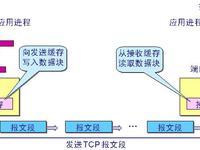要搞清楚read(byte[] b)和readFully(byte[] b)的区别,我从以下方面着手分析:
1.代码的具体实现
2.方法何时返回
3.字节是以什么方式在网络上传输的
1.read(byte[] b)调用read(byte[] b,0,b.length),其中的部分关键代码如下
Java代码
int c = read();//读取字节流中的下一个字节
if (c == -1) {
return -1;
}
b[off] = (byte)c;
int i = 1;
try {
for (; i < len ; i++) {
c = read();
if (c == -1) {
break;
}
b[off + i] = (byte)c;
}
} catch (IOException ee) { }
return i;
int c = read();//读取字节流中的下一个字节
if (c == -1) {
return -1;
}
b[off] = (byte)c;
int i = 1;
try {
for (; i < len ; i++) {
c = read();
if (c == -1) {
break;
}
b[off + i] = (byte)c;
}
} catch (IOException ee) { }
return i;
readFully(byte[] b)调用readFully(byte[] b,0,b.length),其中的部分关键代码如下
Java代码
int n = 0;
while (n < len) {//该方法一直阻塞,直到读取到字节数据缓冲区装满
int count = in.read(b, off + n, len - n);
if (count < 0)
throw new EOFException();
n += count;
}
//read(bytes[] b,int off,int len)中的关键代码
int c = read();
if (c == -1) {
return -1;
}
b[off] = (byte)c;
int i = 1;
try {
for (; i < len ; i++) {
c = read();
if (c == -1) {
break;
}
b[off + i] = (byte)c;
}
} catch (IOException ee) { }
return i;
int n = 0;
while (n < len) {//该方法一直阻塞,直到读取到字节数据缓冲区装满
int count = in.read(b, off + n, len - n);
if (count < 0)
throw new EOFException();
n += count;
}
//read(bytes[] b,int off,int len)中的关键代码
int c = read();
if (c == -1) {
return -1;
}
b[off] = (byte)c;
int i = 1;
try {
for (; i < len ; i++) {
c = read();
if (c == -1) {
break;
}
b[off + i] = (byte)c;
}
} catch (IOException ee) { }
return i;
2.从以上代码,我们可以看到,read(byte[] b)一直阻塞等待读取字节,直到字节流中的数据已经全部读完。而readFully(byte[] b)是当数据缓冲区的空间还有剩余时会阻塞等待读取,直到装满。
3.下图反映了字节流数据是如何通过网络的

应用程序用输出流将数据输入TCP的发送
缓存中,这些数据被分割成TCP认为最适合发送的数据块(报文段或段)。报文段通过网络的传输到达指定地址(URL)的TCP接收缓存中,接收到的报文段很有可能不是顺序到达的,但TCP可以根据报文段的序号进行排序并存储在TCP接收缓存中。应用程序如果需要获得这些数据,需要通过输入流读取并
解析这些报文段。
通过分析以上三个问题,我们可以解释以下代码存在的问题:
Java代码
//发送端:
OutputStream out = ......;//通过TCP连接得到输出流对象
String content = "...";
byte[] data = content.getBytes();
output.write(data);
int len = data.length;
while (len++ < 30) {
output.writeByte('\0');//补够30个字节
}
//接收端:
InputStream in = ......;//通过TCP连接得到输入流对象
byte[] bytes = new byte[30];
in.read(bytes);
//发送端:
OutputStream out = ......;//通过TCP连接得到输出流对象
String content = "...";
byte[] data = content.getBytes();
output.write(data);
int len = data.length;
while (len++ < 30) {
output.writeByte('\0');//补够30个字节
}
//接收端:
InputStream in = ......;//通过TCP连接得到输入流对象
byte[] bytes = new byte[30];
in.read(bytes);
由于字节数据是在网络中通过TCP连接进行传输,这些数据刚刚到达接收端(存储在TCP接收缓冲区)的可能只是其中的一部分数据,其他的数据可能还在传输中甚至在发送端的TCP缓存中。在调用read(byte[] b)读取数据时,b中得到的就是发出的30个字节的一部分。
要想完全获得这30个字节数据,
合理的方法是用readFully(byte[] b)读取,因为该方法会一直阻塞等待,直到30个数据全部到达(数据缓冲区装满)

- 大小: 36 KB
